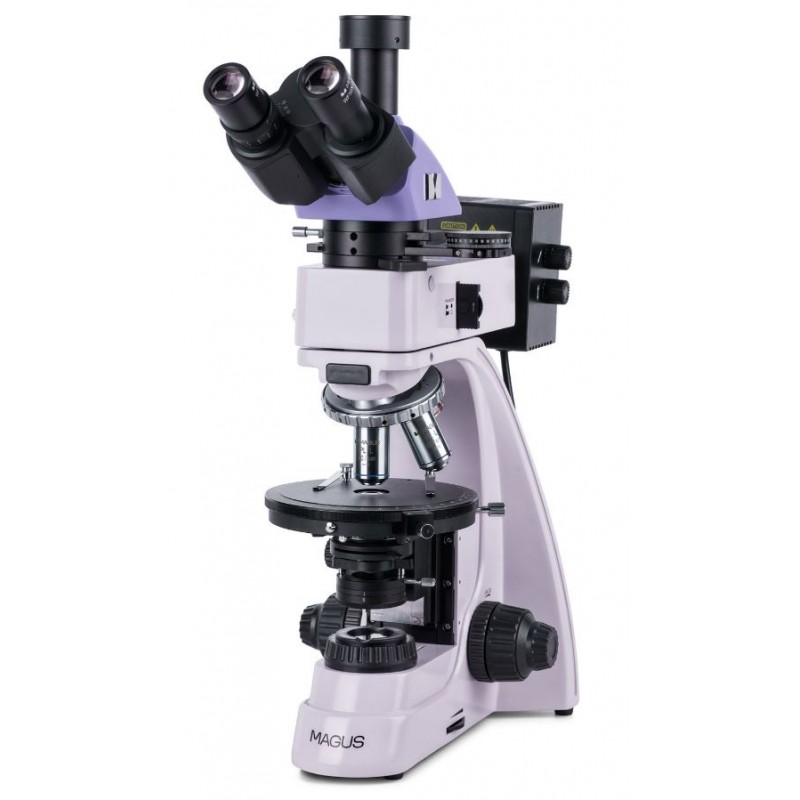Our company is involved in preparing official permits from the Polish Ministry of Development and Technology, which allows us to export all dual-use drones, optics, and portable radiophones without VAT on the Polish side / and without VAT on the Ukrainian side.
MAGUS Pol 850 Polarizing Microscope
300620.89 ₽ net price (non-EU countries)
Anatolii Livashevskyi
Product Manager![]() /
/ ![]()
+48721808900![]() +48721808900
+48721808900![]() +48721808900
+48721808900
[email protected]
Description
MAGUS Pol 850 Polarizing Microscope: Advanced Optical Instrument for Precise Scientific Research
The MAGUS Pol 850 Polarizing Microscope is engineered to provide high-quality observations of specimens in both polarized and natural light, making it an invaluable tool for professionals in fields such as crystallography, petrography, mineralogy, forensics, and medicine.
This sophisticated microscope is designed to study:
- Geological specimens and anisotropic biological and polymeric samples in thin sections using transmitted light.
- Polished sections with one polished side, as well as opaque objects up to 15mm thick, using reflected light.
Key Features:
- Studies transparent and opaque anisotropic samples in polarized and natural light.
- Equipped with a powerful 30W halogen light source for both transmitted and reflected illumination.
- Includes a Bertrand lens for conoscopy and orthoscopy, compensators, and Köhler illumination.
- Trinocular head with a dedicated tube for digital camera mounting; offers 100:0 and 0:100 beam splitting.
- Infinity plan achromatic strain-free objectives eliminate false optic effects.
- Convenient alignment of the revolving nosepiece slots and stage for precise analysis.
- Rotatable round stage with vernier scale for accurate angle measurement.
- Wide range of optional accessories to extend functionality.
Microscope Head:
Features a trinocular head with infinity plan achromatic objectives, allowing for digital image capture. The eyepiece/camera light path selection knob directs light to the digital camera or eyepiece tubes, with diopter adjustment available on the left tube.
Revolving Nosepiece:
Accommodates five objectives, with an additional slot for centering the light source or installing another objective for extra magnification. The design frees up space at the front of the stage, enhancing usability.
Objectives:
Infinity plan achromatic objectives designed for polarized light observations with strain-free optics to ensure birefringence originates from the specimen.
Focusing Mechanism:
Coaxial coarse and fine focusing knobs located at the bottom of the stand for ergonomic use. Features a coarse focusing lock knob and adjustable coarse tension for quick adjustments.
Stage:
360° rotatable stage with angle gradation and vernier scale for precise measurements. Stage centering is achieved with two screws for alignment with the optical axis.
Light Source:
Utilizes 30W halogen bulbs for transmitted and reflected light with a comfortable color temperature for extended observations. Köhler illumination enhances image quality and resolution.
Kit Includes:
- Base with power input, transmitted light source, condenser, focusing mechanism, stage, and revolving nosepiece.
- Reflected light illuminator with lamphouse.
- Trinocular head and intermediate tube with Bertrand lens, analyzer, and compensator slot.
- Compensators: λ compensator, λ/4 compensator, quartz wedge.
- A selection of infinity plan achromatic objectives and eyepieces.
- Additional accessories including a C-mount adapter, hex key wrench, power cord, dust cover, and user manual.
Specifications:
- Product ID: 82912
- Brand: MAGUS
- Warranty: 5 years
- EAN: 5905555018539
- Package Size (LxWxH): 44.7 x 42.2 x 67.5 cm
- Shipping Weight: 11.5 kg
- Type: Biological, light/optical
- Magnification: 50–600x (optional: 25–1000/1600/2000x)
- Eyepiece Tube Diameter: 23.2 mm
- Stage: Ø150 mm, rotatable, with vernier scale
- Illumination: Halogen, with brightness adjustment
- Polarizer: 360° rotatable for transmitted and reflected light
- Application: Laboratory/medical
- Operating Temperature Range: 5 to +35°C
The MAGUS Pol 850 Polarizing Microscope is a precision instrument designed for experienced users and professionals who demand superior optical performance and versatility in their research.
Data sheet
Official permits of the Ministry of Development and Technology
Our company is involved in preparing official permits from the Polish Ministry of Development and Technology, which allows us to export all dual-use drones, optics, and portable radiophones without VAT on the Polish side / and without VAT on the Ukrainian side.



